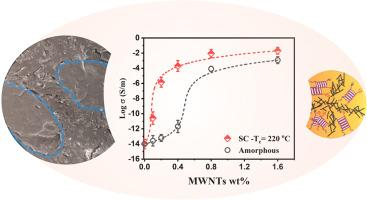Tuning the carbon nanotube conductive network in PLA-based immiscible blends via stereocomplex crystallization
IF 14.2
1区 材料科学
Q1 ENGINEERING, MULTIDISCIPLINARY
引用次数: 0
Abstract
Crystallization-induced segregation of nanoparticles and selective nanoparticle localization in immiscible polymer blends with cocontinuous morphology are effective strategies to control the distribution of conductive fillers to increase electrical conductivity with minimal filler content. In this research, stereocomplex crystallization and double percolation of nanoparticles are combined in 50/50 (PLLA/PDLA)/PVDF blends filled with 0.1–1.6 wt% carbon nanotubes (MWNTs) to achieve high electrical conductivity and electromagnetic shielding performance. During melt crystallization, spherulite-shaped homocrystals form in the 50/50 PLLA/PDLA phase leading to a primary segregated structure with the MWNT nanoparticles localized in the PLA phase. The generated homocrystals are then reformed into stereocomplex crystals upon annealing at elevated temperatures. Thus, a refined segregation of the MWNTs is achieved forming a conductive pathway via enhanced volume exclusion. The SC crystals formed through melting and recrystallization of homocrystals at a high temperature, where there is enough chain mobility, can effectively compact the segregated network which enhances the electrical conductivity and electromagnetic shielding performance. As a consequence, the electromagnetic shielding effectiveness of this sample is double that of samples re-crystallized at a lower crystallization temperature. The different mechanisms at play are analyzed using a range of techniques including differential scanning calorimetry, X-ray diffraction, and microscopy observations. This research demonstrates that stereocomplex crystallization via homo-recrystallization in PLA-based blends can be used as a novel approach to fabricate high-performance conductive and EM shielding composites by exploiting phase morphology and crystallization.

用立体配合物结晶法调谐pla基非混相共混物中的碳纳米管导电网络
结晶诱导的纳米颗粒偏析和纳米颗粒的选择性局部化是控制导电填料分布的有效策略,以最小的填料含量提高电导率。在这项研究中,纳米颗粒的立体络合结晶和双重渗透结合在50/50 (PLLA/PDLA)/PVDF共混物中,填充0.1-1.6 wt%的碳纳米管(MWNTs),以获得高导电性和电磁屏蔽性能。在熔融结晶过程中,在PLLA/PDLA的50/50相中形成球晶状的均晶,导致MWNT纳米颗粒在PLA相中形成初级分离结构。生成的均晶在高温退火后重新形成立体络合晶体。因此,通过增强的体积排斥性,实现了MWNTs的精细分离,形成了导电通路。在具有足够链迁移率的高温条件下,SC晶体通过均晶的熔融和再结晶形成,可以有效地致密分离网络,提高导电性能和电磁屏蔽性能。因此,该样品的电磁屏蔽效能是在较低结晶温度下再结晶样品的两倍。不同的机制在发挥分析使用一系列技术,包括差示扫描量热法,x射线衍射,和显微镜观察。该研究表明,通过均匀再结晶在pla基共混物中进行立体络合结晶可以作为一种利用相形态和结晶技术制备高性能导电和电磁屏蔽复合材料的新方法。
本文章由计算机程序翻译,如有差异,请以英文原文为准。
求助全文
约1分钟内获得全文
求助全文
来源期刊

Composites Part B: Engineering
工程技术-材料科学:复合
CiteScore
24.40
自引率
11.50%
发文量
784
审稿时长
21 days
期刊介绍:
Composites Part B: Engineering is a journal that publishes impactful research of high quality on composite materials. This research is supported by fundamental mechanics and materials science and engineering approaches. The targeted research can cover a wide range of length scales, ranging from nano to micro and meso, and even to the full product and structure level. The journal specifically focuses on engineering applications that involve high performance composites. These applications can range from low volume and high cost to high volume and low cost composite development.
The main goal of the journal is to provide a platform for the prompt publication of original and high quality research. The emphasis is on design, development, modeling, validation, and manufacturing of engineering details and concepts. The journal welcomes both basic research papers and proposals for review articles. Authors are encouraged to address challenges across various application areas. These areas include, but are not limited to, aerospace, automotive, and other surface transportation. The journal also covers energy-related applications, with a focus on renewable energy. Other application areas include infrastructure, off-shore and maritime projects, health care technology, and recreational products.
 求助内容:
求助内容: 应助结果提醒方式:
应助结果提醒方式:


